By Roberto Motta and Pete Vack
Photos courtesy of Roberto Motta, Dino Brunori and Alessandro Nassiri © Archivio Museo Scienza
Nardi
Enrico Nardi was always ahead of his time, even as a youth; take a close look at his very first car, constructed in 1932 with his good friend Augusto Monaco. With more imagination than money, the 25 year old engineering student put together a ladder chassis (designed by Monaco) with a 65 hp V twin JAP engine upfront and a five speed transmission driving the front wheels. It featured inboard front brakes; the lack of a driveshaft allowed the single seat to be positioned very low and it sits very low. Even if it weighed in at only 672 pounds, it was no lightweight contender, winning many hillclimbs in Italian National events from 1933 to 1937.
The elements of a tubular ladder or semi space frame, motorcycle engines and front wheel drive would be seen on many Nardis and Nardi-Danese cars throughout the 1950s. The search for innovation and technology combined with the art of local coachbuilders, continued throughout Nardi’s all too short life. Until his death from Leukemia in 1966, he possessed an inexhaustible passion for four wheels. His creative mind pulsed constantly with new ideas, some good, some bad, but mostly original. He was perhaps most famous for his steering wheels (it was Enzo Ferrari who wisely suggested to Nardi that he stamp his name on steering wheels to prevent copies) and tuning equipment; but like Abarth, these businesses only served to allow Nardi the finances to create automobiles. (Nardi’s complete life and all of his cars are covered in details in Dino Brunori’s book “Nardi, A fast Life”).
Nardis in the SCCA
Nardi’s cars and victories were well known throughout Italy, and also in America. Nardis of all shapes and sizes, from 750cc BMW-engined open wheelers to 2500 cc Alfa engined sports racers could be seen at events all over the States. Most were imported by a lively Italian immigrant by the name of Anthony Pompeo. SCCA racer Jim Pauley was a well known Nardi driver, and appeared at Watkins Glen in 1950 entered by Perry Fina. He finished seventh overall in the Grand Prix event.
The other country in which Nardi would become famous was France. For Nardi knew that not only was the 24 Hours of Le Mans a true endurance test, but appearing in the race would create a great deal of attention. With a little help from his friends, Nardi would become a household word in France as he fought to end the French domination of the 750 cc class.
Nardi at Le Mans, 1954
Turin, not Modena nor Maranello, was the epicenter of Italian auto industry, for it was there that Fiat, Lancia, Abarth, Nardi and many others were located. Surrounding the Fiat works were many other tiny firms which created special bodies and engines for the Fiat products. To help promote a high profile image for Turin’s auto industry, a group of nineteen enthusiasts formed a club, named simply “Racing Club 19” for the number of founding members. Among the founders was a rich doctor by the name of Mario Damonte, who enjoyed endurance racing. Initially he purchased a Fiat 1100 bodied by Rocco Motto, a coachbuilder located in Turin, and tuned by Enrico Nardi.
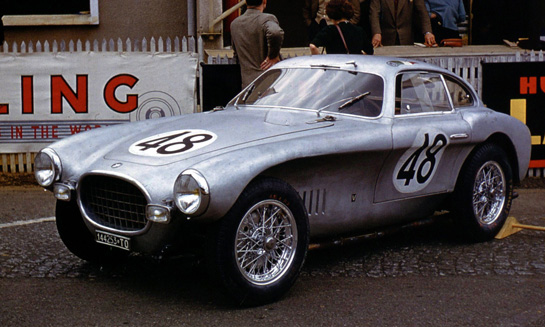
Dr. Damonte won the 750-1100cc class at Le Mans in 1953 with his OSCA. From the book, 'Le Mans, 1949-1950'.
In 1952, Damonte turned to the Maserati brothers and had a special MT4 with a Vignale coupe body built for him. He entered Le Mans in 1952 but retired after 19 laps with clutch problems. He tried again in 1953 and this time succeeded, bringing the beautiful OSCA coupe home in 18th place and winning the 750-1100 cc class.
But for the Turinese car enthusiasts, the goal was to beat the French at their own game…the 750cc class dominated by the Renault and Panhard-based race cars. According to Dino Brunori, Nardi “still had a score to settle” with Panhard (Nardi used Panhard powerplants but the best engines went to Bonnet) and Damonte was eager to promote Turin’s racing products. Damonte suggested that Nardi build a 750 cc car for the 1954 Le Mans. “Yes, I like Mario’s idea…but I will use the American 750cc, for at the test bench it delivers 50 hp,” said Nardi.
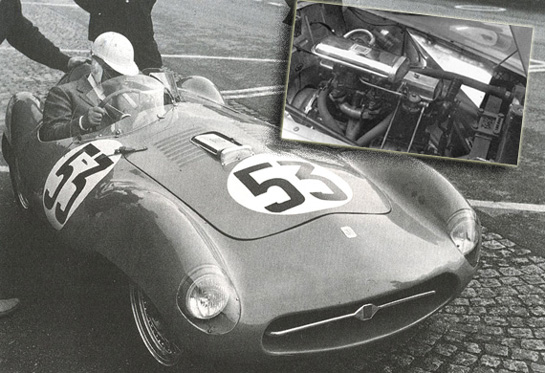
The 1954 Nardi gets ready for a lap at Le Mans with Gacon at the wheel. Inset, the Crosley engine with Nardi modifications.
The Crosley engine was installed in a tubular framed chassis suitably modified to make room for the Crosley block. Nardi made up attractive new wheels and the body was up to Rocco Motto, who created a very curvaceous and attractive barchetta for the new race car.
The car was ready for the Salon de Turin in the spring of 1954, and attracted a good deal of attention. Auto Italiana wrote “The streamlined barchetta prepared for Mr. Damonte for the next Le Mans race..,” which indicated high expectations for the new car. Nardi knew that Le Mans was a brutal testing ground for the most innovative automotive technologies. His new car was characterized by advanced technical choices that allowed the car to achieve high speed, then to settle in, keeping the high speeds for long lengths of time.
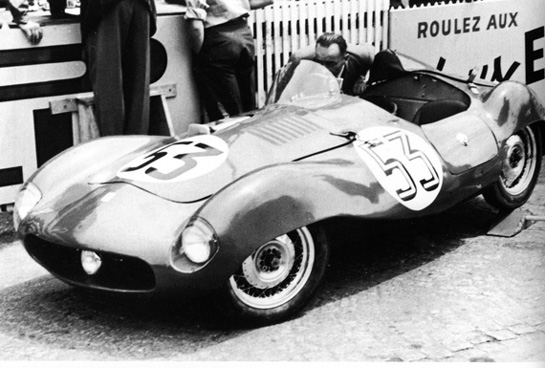
The 750cc Nardi at Le Mans, 1954. Note the attractive wheels and the beautiful Motto bodywork. Photo courtesy Dino Brunori.
Damonte chose French driver Alexandre Gacon to co-drive . The competition was fierce as the French were out in force. Renault, with the backing of its CEO Pierre Lefaucheux, was supplying engines to D.B. while at the same time the D.B. was also getting the best Panhard engines for the HBR MCs. Monopole, Panhard’s racing arm, entered four cars in the 750 cc class. Odds of success for the tiny Nardi team looked less than slim.
But during the event it was a broken water pump that put an end to the Le Mans adventure. In the second hour, even before Damonte had a chance to take the wheel, Gacon retired the car. As Brunori tells it, “In spite of everything, the car had made a favorable impression and Damonte left it at Nardi’s, probably with the intention of using it again at Le Mans the next year.”
Carlo Mollino
At the same time, the engineer-architect, pilot and aircraft enthusiast Carlo Mollino was taken by the lines of Damonte’s OSCA. Mollino had been hired by Damonte to redesign his personal apartment and the two shared an interest in cars. Using a photo of the OSCA as it appeared in a magazine, Mollino began to sketch out an idea for an aerodynamic body that would not cover a racing car chassis, but instead, a chassis would be constructed to conform to the streamlined body. Mollino became part of a new project to create a new car for the 1955 Le Mans. It would become known as the DaMolNar Bisiluro.
In Italia
Enrico Nardi
C’è un ottimo modo per capire il talento progettuale di Enrico Nardi.
Guardate attentamente la sua prima auto costruita nel 1932 con l’amico Augusto Monaco. Con più fantasia che soldi, Nardi aveva 25 anni ed era uno studente d’ingegneria, e pensò di utilizzare un telaio, progettato da Monaco, sul quale montò un propulsore bicilindrico JAP da 65 cv e trasmissione a 5 marce. La vettura era caratterizzata da trasmissione anteriore, freni entrobordo e, grazie all’assenza dell’albero di trasmissione, da un sedile monoposto montato in posizione ribassata.
L’auto pesava 305 kg (672 pound), e tra il 1933 e il 1937, vinse molte gare in salita d’importanza nazionale.
Elementi come il telaio tubolare, motore motociclistico e trazione anteriore furono una costante di molti dei modelli realizzati da Nardi-Danese in tutto il 1950.
Ricerca innovazione, tecnologia, combinata con l’arte manuale di alcuni carrozzieri locali furono una costante per tutta, e purtroppo breve, vita di Nardi.
Fino al momento della sua morte, avvenuta per leucemia nel 1966, Nardi ha sempre avuto una passione inesauribile per le quattro ruote, e dalla sua mente creativa scaturirono sempre nuove idee, alcune buone, altre meno buone, ma soprattutto sempre originali.
Forse, Nardi era più famoso per i suoi volanti (fu Enzo Ferrari che saggiamente suggerì a Nardi di marchiare con il suo nome suoi volanti per evitare copie) o per la sue preparazioni, ma come successe ad Abarth, queste imprese gli consentirono di reperire le finanze per creare le sue automobili.
(Nardi vita completa e tutte le sue vetture sono coperte in dettaglio nel libro di Dino Brunori di “Nardi, Una vita veloce”).
Nardis in the SCCA
Le auto e le vittorie di Nardi erano ben note sia in Italia che negli USA, dove era possibile vedere delle vetture Nardi, di ogni forma e cilindrata, da quelle a ruote scoperte con motore BMW da 750, alle sport con motore Alfa da 2500 cc in molte delle competizione.
La maggior parte di queste vetture, erano importate da Antonio Pompeo, un immigrato italiano.
Il pilota Jim Pauley, esperto di gare SCCA, nel 1950, guidò una Nardi affidatagli da Perry Fina, a Watkins Glen. Teminò il Grand Prix al 7° posto assoluto.
Un altro Paese dove il nome di Nardi divenne famoso e’ la Francia.
Per Nardi la partecipazione alla 24 Ore di Le Mans non era solo un vero test di resistenza, Nardi sapeva che il solo apparire in gara avrebbe destato una grande attenzione su di lui e le sue creature. Grazie all’aiuto dei suoi amici, il nome ‘Enrico Nardi’ divenne familiare in Francia, per aver combattuto e posto fine al dominio delle vetture francesi nella classe 750 cc.
Nardi a Le Mans, 1954
Torino non, Modena o Maranello, era l’epicentro dell’industria automobilistica italiana, perché a Torino c’erano Fiat, Lancia, Abarth e Nardi.
Attorno al marchio Fiat c’erano molte altre società che hanno creato carrozzerie speciali e motori per le auto prodotte da Fiat.
Per contribuire a promuovere un’immagine di alto profilo del settore automobilistico di Torino, un gruppo di diciannove appassionati fondò un club, chiamato semplicemente “Racing Club 19” dal numero dei membri fondatori.
Tra i fondatori c’era Mario Damonte, un medico facoltoso, amante delle gare di durata. Inizialmente, Damonte acquisto’ una Fiat 1100 carrozzata da Motto Rocco e preparata nell’officina di Enrico Nardi. Entrambi avevano la loro officina a Torino.
Nel 1953, Damonte si rivolse ai fratelli Maserati per avere una MT4 speciale con carrozzeria coupé Vignale. Damonte aveva già partecipato alla 24 Ore di Le Mans nel 1952, ma fu costretto al ritiro dopo 19 giri, per problemi alla frizione.
Provò nuovamente nel 1953, quando si iscrisse alla gara con una coupé OSCA, con la quale concluse la gara al 18 ° posto assoluto e 1° della classe 750-1100 cc.
Con quel risultato, per gli appassionati torinesi, fu raggiunto l’obbiettivo di battere i francesi nella classe a loro più congeniale … la classe 750cc, fino a quel momento dominata dalle Renault e da auto da corsa su base Panhard.
In accordo con quanto scritto da Dino Brunori, Nardi “aveva ancora un conto in sospeso” con Panhard (Nardi aveva utilizzato i motori Panhard, ma i motori migliori erano stati assegnati a Bonnet) e Damonte era impaziente di promuovere i prodotti racing di Torino.
Damonte suggerì a Nardi di costruire una vettura di 750 cc per la 24 Ore di Le Mans del 1954. … “Sì, io idea piace Mario … ma userò il 750cc americano, che al banco prova eroga 50 cv”, disse Nardi.
L’auto venne pronta per il Salone di Torino della primavera del 1954, e desto’ molta curiusita’: Auto Italiana scrisse “La snella barchetta preparata per Damonte per la prossima gara di Le Mans ..”, dimostrando grandi aspettative per la Nardi.
Nardi sapeva che Le Mans era un severo banco di prova per le più innovative tecnologie automobilistiche. La sua nuova vettura era caratterizzata da scelte tecniche avanzate che le permettevano di raggiungere velocità elevate, rimanere stabile, e mantenere velocità elevata per lungo tempo.
Damonte scelse come compagno di guida il pilota francese Alexandre Gacon.
La competizione fu feroce per la presenza di molte vetture francesi.
Renault, con il sostegno del suo CEO Pierre Lefaucheux, forniva motori a D.B. mentre allo stesso tempo la D.B. disponeva anche dei migliori motori Panhard per la MC HBR. Monopole, squadra di punta della Panhard, iscrisse quattro vetture nella classe 750 cc. Quindi le probabilità di successo per la piccola squadra Nardi sembravano ridotte a un lumicino.
Ma nel corso della gara la rottura della pompa dell’acqua pose fine all’avventura di Le Mans. Nella seconda ora, prima ancora che Damonte avesse la possibilità di prendere il volante, l’auto fu costretta al ritiro.
Brunori scrive, “Nonostante tutto, la macchina aveva fatto una buona impressione e lasciò la vettura con Nardi, probabilmente con l’intenzione di utilizzarla nuovamente a Le Mans il prossimo anno”.
Mollino
Allo stesso tempo, l’ingegnere-architetto, pilota e appassionato di aerei Carlo Mollino rimase affascinato dalle linee della OSCA di Damonte.
Mollino era stato Assunto da Damonte per ridisegnare il suo appartamento, e i due condividevano l’interesee per le Automobili.
Utilizzando una foto della OSCA che era apparsa su una rivista, Mollino cominciò a sviluppare un’idea per una carrozzeria aerodinamica, che non avrebbe dovuto adeguarsi a coprire il telaio di una vettura da corsa, ma viceversa, sarebbero state la forme del telaio che avrebbe dovuto adeguarsi alle linnee aerodinamiche della carrozzeria
Molino divenne parte di un nuovo progetto per realizzare una vettura con cui partecipare alla 24 Ore di Le Mans del 1955. La vettura sarebbe diventata nota come il Bisiluro DaMolNar.
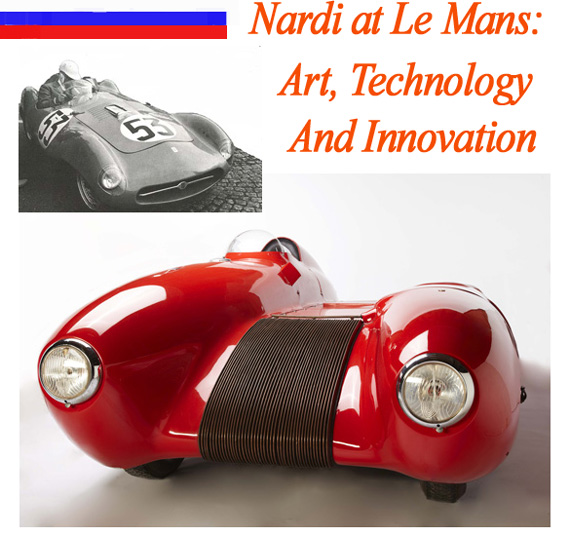
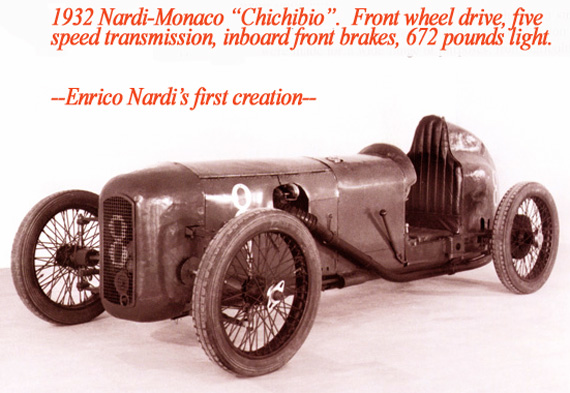
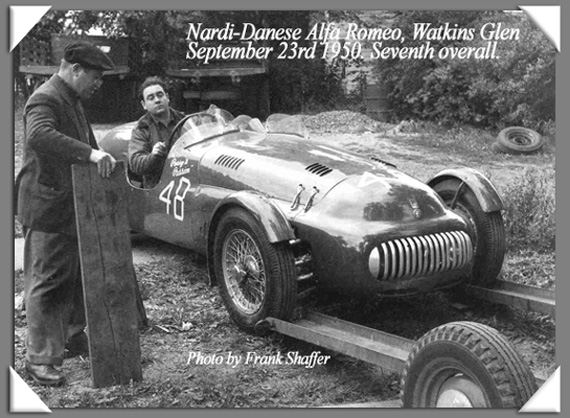
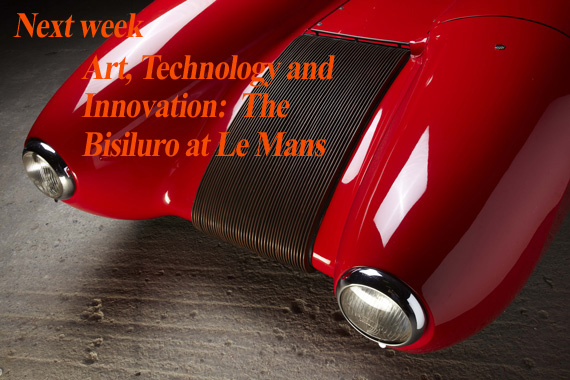
Great Nardi … leave for ever !!!
Great reminiscences of Nardi. I visited his shop in Turin in 1958, finding many wonderful things and meeting the man. He kindly gave me a steering wheel for my 300SL.
One of my favourites though not successful was his mid-engined Lancia-powered F2 car. Great design for its time. But what happened to it?
I met Damonte at a dinner in Turin thanks to my friend Rudy Mailander. But my Italian wasn’t up to a proper conversation at the time.
When in consulting I had the idea of reviving the wonderful little BMW-twin-powererd two-seater Nardi with cycle fenders. I had permission from the Nardi rights holders to do it but…never got around to it.
Super cars